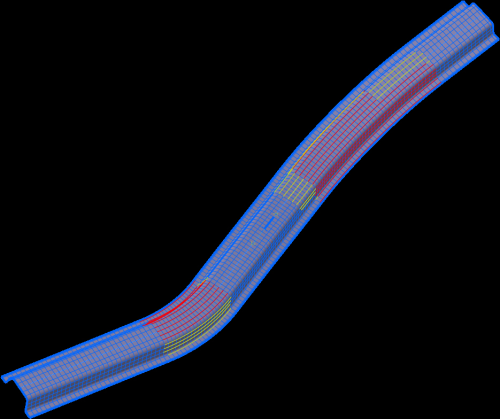
Fibersim is used in the aerospace, automotive and wind energy industries to optimise the design and manufacture of composite structures. It is developed by Vistagy Inc, which was acquired by Siemens in December 2011.
Fibersim 2012 reduces uncertainty in the performance of composite parts by defining, communicating, and validating desired fibre orientations throughout the product development process, ensuring that they meet specifications. By eliminating design interpretation errors, this new release reduces the risk of producing over-engineered parts that not only behave unpredictably, but are also heavier and more costly than necessary.
Specific benefits of Fibersim 2012 include:
- Increased opportunities for optimising designs: Fibersim 2012 increases confidence in the way manufactured composite parts perform by providing a new Spine-Based Rosette, enabling desired fibre orientations to be defined along a path that can then be communicated and validated throughout the development cycle. Maintaining desired fibre orientations in manufactured parts (whether an airframe stringer, an automotive C frame, or a 60 m wind turbine blade) is critical to optimising weight and performance.
- Accurately simulating how composite materials conform to complex shapes: Fibersim 2010 introduced new material and process simulations for multilayered materials, including non-crimp fabric and ply forming simulations. Fibersim 2012 builds on these capabilities to simulate a greater number of materials and manufacturing processes used with the Spine-Based Simulation for parts produced using steered fibre methods. Steering fibres along the path of an aerostructure stringer, an automotive B pillar or a scribed line on a wind turbine blade mould will cause localised buckling and deformation. By identifying these issues early in the design cycle, key decisions can be made to ensure expected part strength is achieved in a timely and cost-effective manner.
- Efficiently communicating a complete part definition between design and analysis: The new version introduces a breakthrough in the exchange of multiaxial material and core data to allow for efficient communication of two critical design components between analysts and designers throughout the iterative development cycle. Accurate analysis of part stiffness and strength necessitates the inclusion of multiaxial and core materials commonplace in aerospace, automotive, and wind energy designs.
- Simplifying composite part development and documentation: Fibersim 2012 simplifies composite development with new, intuitive tools for design and documentation for engineers with different levels of composites experience. The most challenging and time-consuming design task is capturing drop-off specifications for regions of varying thickness. Fibersim 2012 introduces a new Stagger Editor, a visual drag and drop method for easily capturing those specifications. Large aerospace panels, such as wings, stabilisers or empennage, have a significant number of different drop-off profiles. The Stagger Editor makes it easy to develop the profiles and reduce design errors.
“The innovations in the latest version of Fibersim are born from our conviction that the most effective way to address composite engineering and manufacturing challenges is to develop industry-specific solutions,” says Leigh Hudson, director of product and market strategy for Fibersim.
“Fibersim 2012 provides end-to-end solutions for developing and optimising composite part types that are common to aerospace, automotive, wind energy and other industries, enabling our users to develop robust products on schedule and on budget and, ultimately, to meet their goals.”



